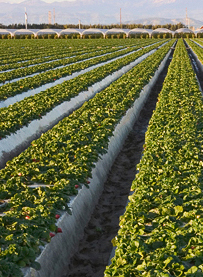PEAR
The Problem
On hot summer afternoons, the demand for electricity spikes as businesses, farms and individuals call for more electricity for seasonal air conditioning and irrigation loads. This increased demand for power in a narrow window of time creates a peak energy demand. To meet this occasional peak demand, a significant portion of system resources such as transformers, substations, peak generation plants, conductors, and switching gear must be in place and operationally ready. For the remainder of the year, these assets are often idle or underutilized. Because the utility is required to meet these peak demands, the costs for these assets are deemed prudent by regulatory bodies and are passed along to consumers as a part of the rate base.
California’s Central Valley
For many electrical utilities, agriculture is a significant component of their peak load. Nowhere is this more evident than in the central valley of California, one of the world's most productive agricultural regions. The central valley produces 8 percent of the nation’s agricultural output and accounts for over $17 billion in gross production value. About one-sixth of the irrigated land in the U.S. is in the central valley. Pacific Gas & Electric (PG&E) and Southern California Edison (SCE) serve the growers in the central valley and their 160,000+ irrigation pumps. These pumps account for over 4,000 Megawatts (MW) of peak load.
Peak Energy Agricultural Rewards (PEAR)
M2M has teamed up with PG&E, SCE, and the US Department of Energy to create the PEAR program. The project is partially sponsored by a grant of $2.1 Million as a part of the Department of Energy’s Smart Grid Investment Grant program.
Using our collective knowledge of agricultural load control systems, M2M Communications and the PEAR program will facilitate the shifting of a large peak electrical load and significantly reduce the need for peak power.
The PEAR program will:
- Demonstrate the program benefits to the California growers
- Enroll participating growers into the utility load control programs
- Install intelligent control equipment at the irrigation pump sites
- Dispatch peak power on a daily basis as required by the utility, and
- Maintain the Network Operations Center, secure web site, and all field equipment.
The M2M Lodestar Irrigation Load Control system benefits everyone involved – grower, utility and the general public. The design of the PEAR program is based on years of farmer and utility feedback. It implements load control functionality in the least disruptive manner. The PEAR solution will:
- Dispatch power on demand and only when needed
- Provide web-based monitoring and control functionality to both the farmer and utility
- Facilitate customer notifications of load control events by phone, text, and/or e-mail
- Enable the farmer to opt-out of a specific event if necessary
- Provide two-way communications anywhere
- Report demand data before, during, and after an event
- Interface to related utility software control systems
The application of Lodestar advanced digital technologies and the PEAR program will improve the reliability, security, interoperability, and efficiency of the electric grid, while reducing environmental impacts and promoting economic growth.
The M2M project will directly enable measurable improvements in:
- The reliability of the electric power system
- Electric power system costs and peak demand
- Consumer electricity costs, bills, and environmental impacts
- Economic opportunities for businesses and new jobs for workers
For more information, please visit www.m2mcomm.com and www.pearcalifornia.com

